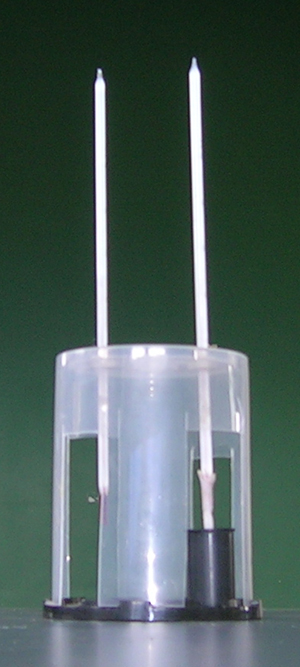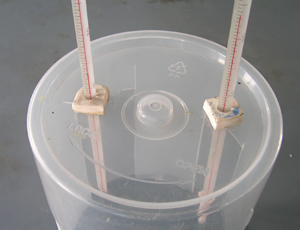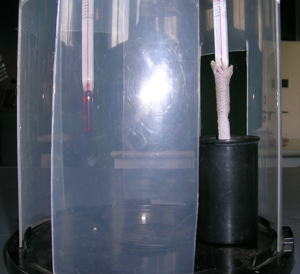Relative Humidity
DIY - Model 1
Making a Simple Hygrometer
An instrument to estimate relative humidity is called a Hygrometer. Making one is rather simple. We are making one that is called dry and wet bulb hygrometer
In our instrument we used
a) Two thermometer - 1 to 50 deg. C scale.
b) One 100 CD/DVD cake box with its spindle removed.
c) 35 mm film container.
d) Eraser.
e) 5 cm long cotton wick (a porous muslin cloth will do).
 In this design we have used CD/DVD cake box for mounting thermometers.
For the free flow air we have cut four big windows in the box. Be
very careful not to cut these windows where there is a locking mechanism
to lock the transparent top of the box to its black base. Make these windows
as big as possible and that it would be easy for you to put in the 35mm film container.
In this design we have used CD/DVD cake box for mounting thermometers.
For the free flow air we have cut four big windows in the box. Be
very careful not to cut these windows where there is a locking mechanism
to lock the transparent top of the box to its black base. Make these windows
as big as possible and that it would be easy for you to put in the 35mm film container.
Two holes are made on the top of the CD/DVD cake
box just big enough for the thermometers to slide in.
The CD/DVD box material is quite thin and by simply sliding-in the thermometers will not stand quite vertically. So take two pieces of erasers and make holes just big enough for thermometers to slide in snugly.
You should be very careful in doing this operation. By applying extra force you can break thermometers.
Fixing erasers to the box could be quite tricky
for you will have to match the holes in the CD box and the erasers.
We used Araldite to stick the rubber to the plastic. Normal rubber
solution did not work quite very well. First insert the thermometers into
the erasers. Apply a bit of Vaseline or some oil on the thermometer. It
will help in sliding the thermometer and also prevent glue sticking to the
glass. Apply Araldite (well mixed epoxy resin and harder) evenly on
the eraser. Slide in the thermometer into the hole in the box until the
eraser rests on the box. Push the thermometer down enough so that
it's weight will make it stand vertically. It will take 24 hours for the glue to
dry.
will make it stand vertically. It will take 24 hours for the glue to
dry.
Our instrument is now ready. Insert the cotton wick over the bulb of one of the thermometer. The temperature reading of this thermometer will be called wet bulb reading. Place the 35 mm film container below this thermometer and adjust the height such a way that there is a gap of about 1 cm between the end of the thermometer and the container. Adjust the height of the other thermometer. The temperature reading of this thermometer will be dry bulb reading.
Put water in the container under the web bulb thermometer. You will see the water rising along the threads of the wick and soon the wick will be completely wet. If this does not happen you are using wick made of wrong material. You will also notice that rapid fall in the temperature reading but soon it will stabilize.
You instrument is ready. Note the temperatures of dry and wet bulb and using the relative humidity table estimate and record the relative humidity.
Please note:
Some of the observations taken may not be as good as those taken by professional observatories but the aim here is to learn to do scientific experiments and take observations, as accurately as possible.
Send us your design (s) - we would be happy to share it with others
 The material here can be used freely. It is however expected that the source will be acknowledged.
The material here can be used freely. It is however expected that the source will be acknowledged.